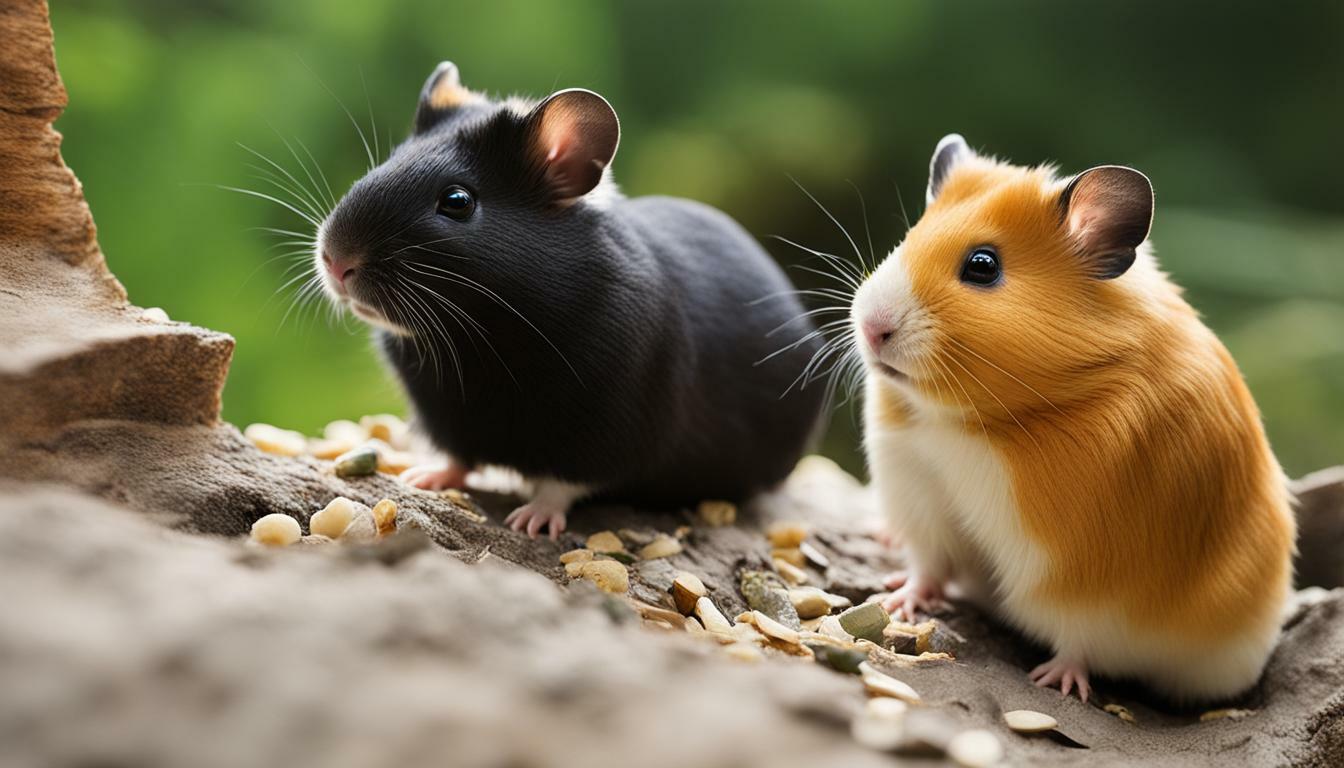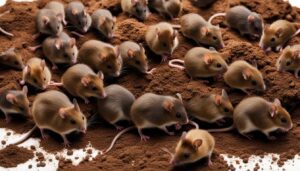Hamsters and guinea pigs may both be small furries with similar physical features, but there are several key differences between the two. While they both belong to the order Rodentia, guinea pigs belong to the Caviidae family while hamsters belong to the Cricetidae family.
In terms of size, guinea pigs are much larger, typically measuring between 20-30cm compared to a hamster’s 5-15cm. Guinea pigs also have a longer lifespan, living 5-8 years compared to a hamster’s 2-3 years.
In terms of diet, guinea pigs are herbivorous and primarily eat hay, grass, and vegetables, while hamsters are omnivorous and can eat both plant material and insects.
Guinea pigs are social animals and enjoy interacting with others, while hamsters are more solitary and can become aggressive in the presence of other hamsters. Behaviorally, guinea pigs are active during the day while hamsters are more active at night.
Additionally, guinea pigs have a sensitive respiratory system and require vitamin C in their diet, while hamsters are more prone to certain health issues such as “wet tail.”
It is also important to note that hamsters are banned as pets in Australia due to the threat they pose to native flora and fauna.
- Guinea pigs are larger than hamsters and have a longer lifespan.
- Hamsters are omnivorous, while guinea pigs are herbivorous.
- Guinea pigs are social animals, while hamsters are more solitary.
- Guinea pigs are active during the day, while hamsters are more active at night.
- Guinea pigs have a sensitive respiratory system, and hamsters are prone to “wet tail” disease.
Size Comparison
When it comes to size, guinea pigs are much larger than hamsters, typically measuring between 20-30cm compared to a hamster’s 5-15cm. This significant difference in size is one of the most apparent distinctions between the two species. Guinea pigs have a stout and robust build, with a compact body and a rounded head. Their larger size makes them easier to handle and interact with, making them a popular choice for families and children.
Hamsters, on the other hand, have a smaller and more delicate stature. They have a slender body with a pointed snout and small rounded ears. Their compact size allows them to maneuver through narrow spaces and burrow easily. Due to their smaller size, hamsters are often kept in cages that provide a secure and comfortable environment for them.
It’s important to consider the size difference between hamsters and guinea pigs when deciding which pet is right for you. If you have limited space or prefer a smaller pet, a hamster might be a suitable choice. However, if you’re looking for a larger and more interactive companion, a guinea pig would be a better fit.
| Hamster | Guinea Pig |
|---|---|
| Size: 5-15cm | Size: 20-30cm |
| Lifespan: 2-3 years | Lifespan: 5-8 years |
| Diet: Omnivorous | Diet: Herbivorous |
| Behavior: Solitary | Behavior: Social |
Lifespan and Care Differences
Guinea pigs have a longer lifespan, living 5-8 years compared to a hamster’s 2-3 years, which means they require a longer-term commitment when it comes to pet ownership. Proper care is essential to ensure the well-being of both these adorable furballs. Here are some key differences in their care requirements:
- Enclosure: Guinea pigs need a larger living space than hamsters due to their bigger size. A spacious cage with ample room for exercise is essential. Additionally, guinea pigs should not be housed in wire-bottomed cages as it can cause harm to their delicate feet.
- Diet: Guinea pigs have specific dietary needs and require a constant supply of hay, fresh vegetables, and vitamin C-rich foods. On the other hand, hamsters have a more varied diet that includes both vegetables and insects. It’s important to provide a well-balanced diet for both species to ensure their nutritional needs are met.
- Interaction: Guinea pigs are social animals and thrive on companionship. It’s recommended to keep them in pairs or groups to prevent loneliness and provide mental stimulation. In contrast, hamsters are more solitary creatures and may become territorial or aggressive if housed together.
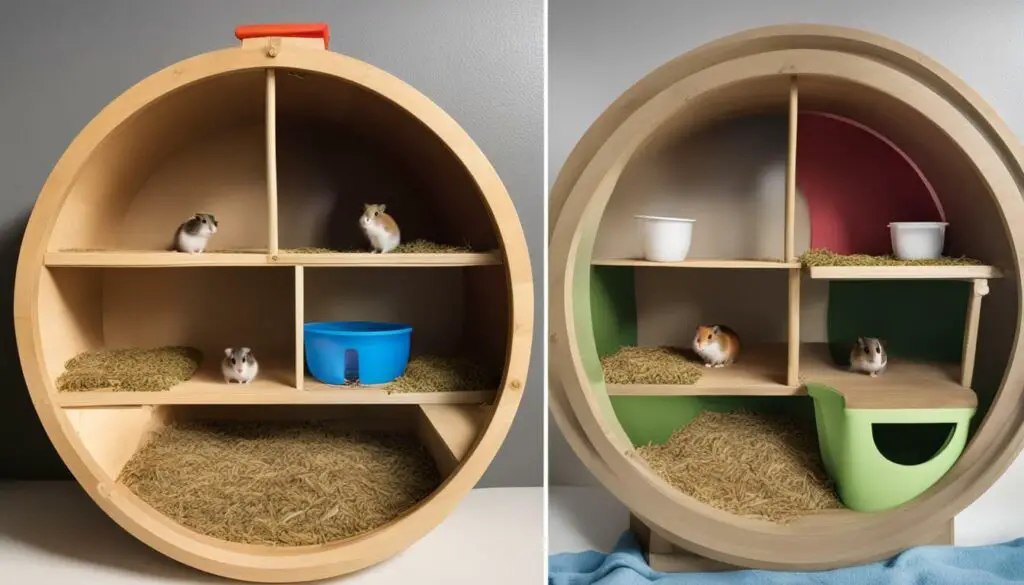
Additionally, grooming and hygiene play a crucial role in their care. Guinea pigs require regular nail trims and occasional baths to keep them clean and prevent any health issues. Hamsters, on the other hand, are meticulous self-groomers and usually do not require frequent bathing.
To summarize, when choosing between hamsters and guinea pigs, it’s important to consider the longer lifespan and the commitment required for their care. Guinea pigs thrive on social interaction and have specific dietary needs, while hamsters are more independent and have a more varied diet. By understanding these differences, you can provide the best care for your furry friend and ensure their well-being.
Diet Variations
When it comes to diet, guinea pigs are herbivorous and primarily eat hay, grass, and vegetables, while hamsters are omnivorous and can eat both plant material and insects. Guinea pigs require a constant supply of hay to support their digestive system and wear down their continuously growing teeth. Fresh vegetables such as leafy greens, carrots, and bell peppers are also important for their vitamin C needs, as guinea pigs, unlike hamsters, cannot produce this vitamin on their own. It is essential to provide a well-balanced diet for guinea pigs to prevent nutritional deficiencies.
Hamsters, on the other hand, have more diverse dietary requirements. They can eat a variety of foods including grains, seeds, fruits, vegetables, and even small amounts of lean meat or insects. However, it is important to note that certain fruits and vegetables should be given in moderation due to their high sugar and water content, which can cause digestive issues in hamsters. Pellet food formulated specifically for hamsters can also be included in their diet to ensure they receive the necessary nutrients.
Table 1: Sample Diet for Guinea Pigs and Hamsters
| Guinea Pigs | Hamsters | |
|---|---|---|
| Hay | Unlimited | Small amount |
| Vegetables | Leafy greens, carrots, bell peppers, etc. | Moderate amount, avoiding high sugar and water content |
| Fruits | Occasional treat | Moderate amount, avoiding high sugar content |
| Grains and Seeds | Minimal amount | Moderate amount |
| Insects or Lean Meat | Not necessary | Small amount as occasional protein source |
| Pellet Food | Not necessary, but can be included for additional nutrients | Formulated hamster pellets can be given in moderation |
It’s important to remember that individual animals may have specific dietary needs or restrictions, and consulting with a veterinarian can provide personalized guidance for your pet’s nutrition. Ensuring a balanced and appropriate diet is essential for the overall health and well-being of both guinea pigs and hamsters.
Social Behavior
Guinea pigs are social animals and enjoy interacting with others, while hamsters are more solitary and can become aggressive in the presence of other hamsters. Guinea pigs thrive when housed together and often form close bonds with their cage mates. They communicate with each other through various vocalizations, such as squealing when excited or purring when content. It’s important to provide guinea pigs with companionship to prevent boredom and loneliness.
On the other hand, hamsters are naturally solitary creatures and prefer to live alone. When two hamsters are housed together, they may fight and display aggressive behavior. This aggression is particularly common among Syrian hamsters, which are known to be territorial. It’s essential to provide each hamster with its own living space and avoid introducing them to other hamsters to prevent any potential conflicts.
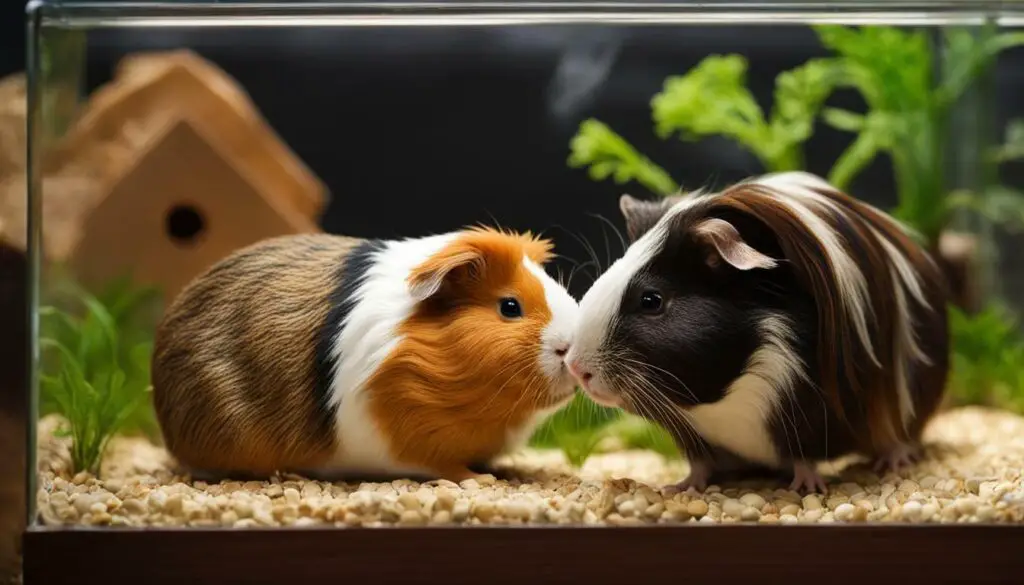
In summary, guinea pigs and hamsters have contrasting social behaviors. Guinea pigs enjoy the company of their own kind and thrive in groups, while hamsters are solitary animals that prefer to live alone. It’s important for pet owners to consider the social needs of these animals and provide them with appropriate housing arrangements to ensure their well-being.
Activity Patterns
Behaviorally, guinea pigs are active during the day while hamsters are more active at night, which can impact the interaction and playtime with their owners. Guinea pigs, being diurnal creatures, enjoy exploring, playing, and socializing during daylight hours. They are often seen running around their enclosure, interacting with toys, and seeking attention from their human companions. Guinea pigs are known for their friendly and sociable nature, making them great pets for those who have ample time during the day to devote to their furry companions.
On the other hand, hamsters are nocturnal animals, meaning they are most active during the night. This makes them more suitable for individuals who have a nighttime schedule or prefer a pet that is awake and active during the evening hours. Hamsters are known to be energetic and agile, often engaging in activities such as running on their exercise wheels, burrowing in their bedding, and exploring their surroundings under the cover of darkness.
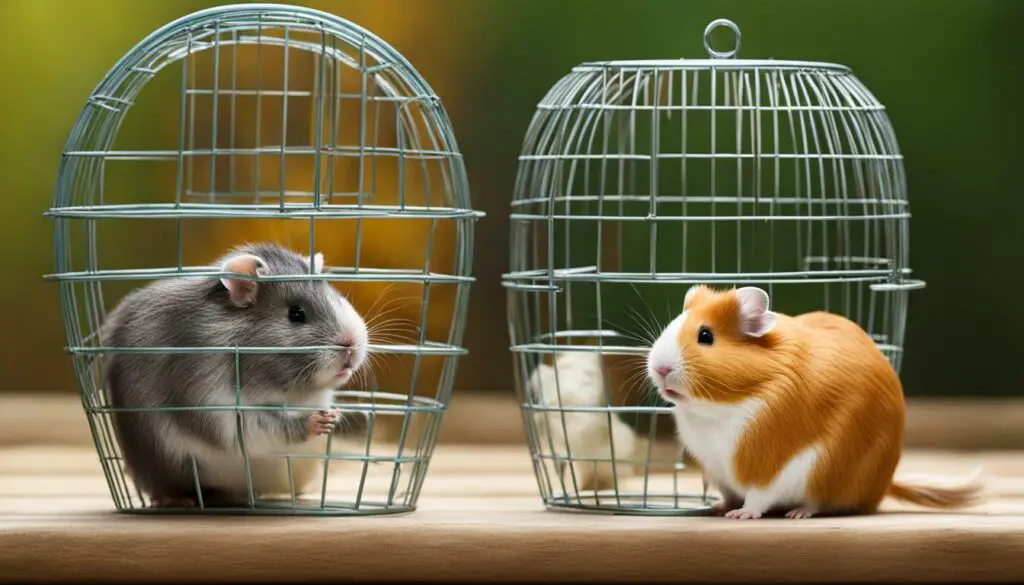
In terms of interaction and playtime, it is essential to consider these activity patterns. Guinea pigs thrive on daily handling and social interaction with their owners. They enjoy being gently held, petted, and engaging in interactive play sessions. On the other hand, hamsters require a more hands-off approach during their nocturnal hours. While they may still enjoy occasional handling, it is crucial to respect their natural sleep-wake cycle and provide them with opportunities for play and exercise during their active periods.
Understanding the activity patterns of guinea pigs and hamsters is essential for creating a suitable environment and schedule that meets their specific needs. By aligning your own daily routine with the natural behavior of your chosen pet, you can ensure a harmonious and fulfilling relationship for both of you.
| Guinea Pigs | Hamsters |
|---|---|
| Active during the day | Active at night |
| Enjoy social interaction | Prefer solitary lifestyle |
| Engage in daytime playtime | Engage in nighttime exercise |
Health Considerations
Guinea pigs have a sensitive respiratory system and require vitamin C in their diet, while hamsters are more prone to certain health issues such as “wet tail.”
Guinea pigs, like humans, are unable to produce their own vitamin C and therefore rely on dietary intake to meet their needs. A lack of vitamin C can lead to scurvy, a condition characterized by weakness, poor appetite, and swollen joints. It is essential for guinea pig owners to provide a balanced diet that includes fresh fruits and vegetables, which are rich in vitamin C. Additionally, guinea pigs are susceptible to respiratory infections, and exposure to drafts, damp environments, or irritants such as dust or cigarette smoke can worsen their respiratory health.
In contrast, hamsters are more prone to a condition called “wet tail.” It is a bacterial infection that affects the hamster’s digestive system and is characterized by diarrhea, lethargy, and a wet appearance around the tail area. It is crucial for hamster owners to maintain clean and hygienic living conditions for their pets, as stress and unclean environments can contribute to the development of wet tail. Prompt veterinary care is necessary if a hamster shows symptoms of this serious condition.
| Guinea Pigs | Hamsters |
|---|---|
| Require vitamin C in their diet | Prone to “wet tail” bacterial infection |
| Sensitive respiratory system | – |
| – | Short lifespan of 2-3 years |

Guinea pigs have a sensitive respiratory system and require vitamin C in their diet, while hamsters are more prone to certain health issues such as “wet tail.”
In conclusion, understanding and addressing the specific health needs of your pet hamster or guinea pig is crucial for their overall well-being. Providing a balanced diet, regular veterinary check-ups, and maintaining a clean and stress-free environment are essential for keeping these furry friends healthy and happy.
Legal Restrictions
It is important to note that hamsters are banned as pets in Australia due to the potential harm they can cause to the country’s native wildlife. The unique ecosystem in Australia, with its diverse flora and fauna, is especially vulnerable to invasive species. Hamsters, originally from Europe and Asia, have the potential to disrupt the natural balance and compete with native species for resources.
The ban on hamsters as pets is part of Australia’s strict biosecurity measures, aimed at protecting the country’s delicate ecosystem. The Australian government has implemented this prohibition to prevent potential harm and preserve its unique wildlife. While hamsters are popular pets in many parts of the world, owning one in Australia is strictly prohibited.
This ban has been in place for several decades. The Australian authorities regularly enforce strict quarantine regulations to prevent the introduction of non-native species. These regulations are crucial in safeguarding the country’s native flora and fauna, ensuring the preservation of Australia’s natural heritage.
“Australia has a diverse range of unique animal species, and it is important to protect them from potential threats. The ban on hamsters as pets is an integral part of our efforts to preserve the delicate balance of our environment.” – Australian Department of Environment and Energy
| Hamsters (Cricetidae Family) | Guinea Pigs (Caviidae Family) |
|---|---|
| Size: 5-15cm | Size: 20-30cm |
| Lifespan: 2-3 years | Lifespan: 5-8 years |
| Diet: Omnivorous | Diet: Herbivorous |
| Behavior: Solitary | Behavior: Social |
| Activity: Nocturnal | Activity: Diurnal |
While hamsters and guinea pigs may share some physical similarities, it is crucial to understand the distinct differences between them. Guinea pigs are larger in size, have a longer lifespan, and have specific dietary needs as herbivores. On the other hand, hamsters are omnivorous, more solitary, and have a unique nocturnal activity pattern.
As a responsible pet owner, it is important to respect and adhere to the legal restrictions imposed to protect the environment. By doing so, we can help safeguard the delicate ecosystem and preserve the native wildlife for generations to come.
Conclusion
In conclusion, while there are similarities between hamsters and guinea pigs, they have distinct differences in size, diet, behavior, and lifespan. Guinea pigs are larger in size, measuring between 20-30cm compared to a hamster’s 5-15cm. They also have a longer lifespan, living 5-8 years compared to a hamster’s 2-3 years.
When it comes to diet, guinea pigs are herbivorous and primarily eat hay, grass, and vegetables. Hamsters, on the other hand, are omnivorous and can eat both plant material and insects.
Behaviorally, guinea pigs are social animals and enjoy interacting with others, while hamsters are more solitary and can become aggressive in the presence of other hamsters. Additionally, guinea pigs are active during the day, while hamsters are more active at night.
It’s important to note that guinea pigs have a sensitive respiratory system and require vitamin C in their diet, while hamsters are more prone to certain health issues such as “wet tail.” Lastly, hamsters are banned as pets in Australia due to the threat they pose to native flora and fauna.
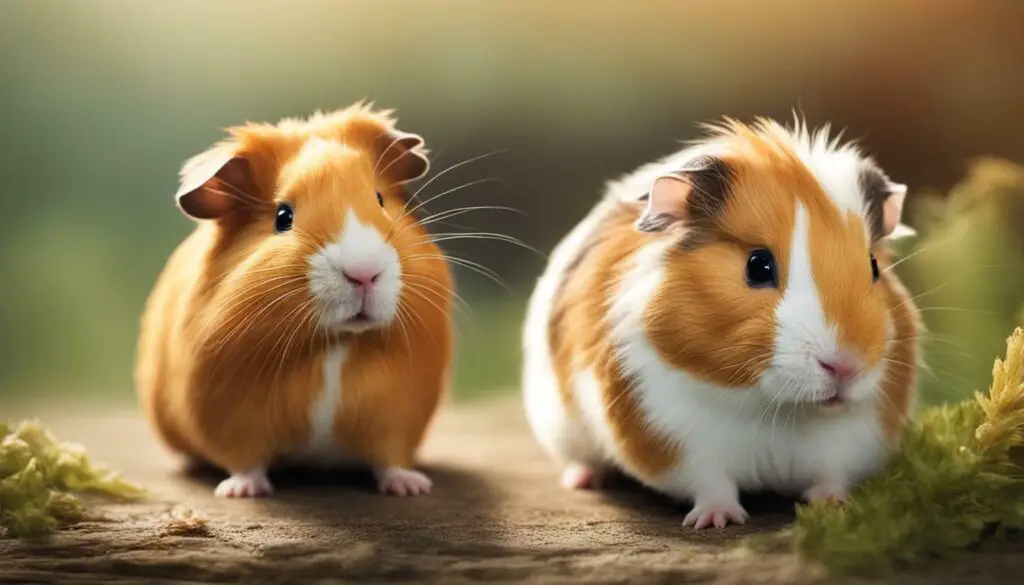
- Guinea pigs are known for their distinctive vocalizations, including squeaks, purrs, and wheeking noises.
- Hamsters are known for their ability to store food in their cheek pouches, which can stretch to almost the length of their bodies.
- Both hamsters and guinea pigs make great pets for individuals or families looking for small, low-maintenance companions.
Comparison Table: Hamsters vs Guinea Pigs
| Hamsters | Guinea Pigs | |
|---|---|---|
| Size | 5-15cm | 20-30cm |
| Lifespan | 2-3 years | 5-8 years |
| Diet | Omnivorous | Herbivorous |
| Social Behavior | Solitary | Social |
| Activity Patterns | Nocturnal | Diurnal |
Additional Notes
It’s worth noting that both hamsters and guinea pigs make popular choices as pets, but understanding their differences is crucial for making an informed decision.
Factual data supports the notable differences between these two furry companions. While they both fall under the order Rodentia, guinea pigs belong to the Caviidae family, whereas hamsters belong to the Cricetidae family. In terms of size, guinea pigs tower over hamsters, measuring an average of 20-30cm compared to the smaller 5-15cm of hamsters. Additionally, guinea pigs enjoy a longer lifespan, ranging from 5 to 8 years, while hamsters typically live for 2 to 3 years.
One noticeable difference lies in their dietary preferences. Guinea pigs are herbivorous and thrive on a diet of hay, grass, and vegetables. On the other hand, hamsters are omnivorous, able to consume both plant material and even insects. These distinctions in diet are essential to ensure the well-being and health of each pet.
Behaviorally, guinea pigs are highly sociable animals that enjoy the company of their fellow guinea pigs. They thrive in pairs or groups and actively engage in social interactions. Conversely, hamsters are more solitary creatures and tend to become aggressive when placed in the presence of other hamsters. Understanding their behavior is vital when considering the companionship needs of these adorable pets.
Lastly, their activity patterns differ significantly. Guinea pigs are diurnal, meaning they are most active during the day. On the other hand, hamsters are nocturnal and prefer to be active during the night. This distinction should be considered in terms of their interaction and engagement with their human companions.
When it comes to health considerations, guinea pigs have a more sensitive respiratory system and require a diet rich in vitamin C. Hamsters, on the other hand, are more prone to certain health issues such as “wet tail,” a bacterial infection that affects their digestive system. Being aware of these health differences helps ensure the well-being of these delightful pets.
And finally, it is important to mention that hamsters are banned as pets in Australia due to the threat they pose to the country’s native flora and fauna. This legal restriction should be taken into consideration if residing in Australia and contemplating hamster ownership.
In conclusion, while hamsters and guinea pigs may share some similarities, their differences in size, diet, behavior, lifespan, and even legal status in certain countries make them distinct pets. By understanding these nuances, pet owners can choose the best fit for their lifestyle and provide the utmost care for their adorable companions.
FAQ
What are the main differences between hamsters and guinea pigs?
Hamsters and guinea pigs have several key differences, including their size, diet, behavior, and lifespan.
How big do guinea pigs and hamsters get?
Guinea pigs are much larger, usually measuring between 20-30cm, while hamsters are smaller, typically measuring between 5-15cm.
How long do guinea pigs and hamsters live?
Guinea pigs have a longer lifespan, living 5-8 years, while hamsters live for about 2-3 years.
What do guinea pigs and hamsters eat?
Guinea pigs are herbivorous and primarily eat hay, grass, and vegetables, while hamsters are omnivorous and can eat both plant material and insects.
Are guinea pigs and hamsters social animals?
Guinea pigs are social animals and enjoy interacting with others, while hamsters are more solitary and can become aggressive in the presence of other hamsters.
When are guinea pigs and hamsters most active?
Guinea pigs are active during the day, while hamsters are more active at night.
Do guinea pigs and hamsters have any specific health considerations?
Guinea pigs have a sensitive respiratory system and require vitamin C in their diet, while hamsters are more prone to certain health issues such as “wet tail.”
Can you keep hamsters as pets in Australia?
No, hamsters are banned as pets in Australia due to the threat they pose to native flora and fauna.

